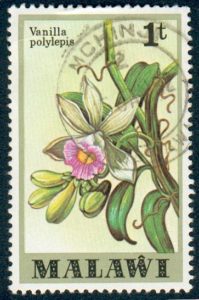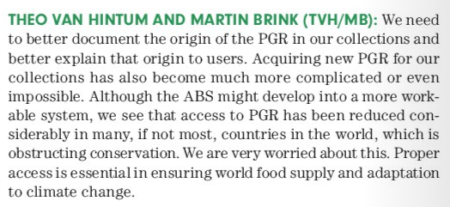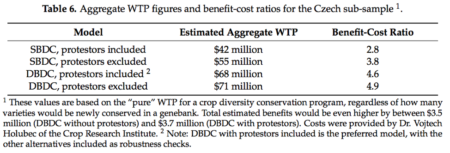- Conserving and Sharing Taro Genetic Resources for the Benefit of Global Taro Cultivation: A Core Contribution of the Centre for Pacific Crops and Trees. The first line of defence against Taro Leaf Blight, among other things.
- Female access to fertile land and other inputs in Zambia: why women get lower yields. Because they’re stuck with the poorer soils. I’m assuming there was some control for maize variety, but the damn thing is behind a paywall. LATER: Yeah, they controlled for hybrid vs open pollinated variety.
- Towards a dialogue of sustainable agriculture and end-times theology in the United States: insights from the historical ecology of nineteenth century millennial communes. In other news, it has become necessary to reconcile the apocalypse with sustainability.
- Population genomic analyses of the chocolate tree, Theobroma cacao L., provide insights into its domestication process. Domestication was both good and bad.
- The use and domestication of Theobroma cacao during the mid-Holocene in the upper Amazon. Archaeology says domestication in western Amazon in line with above (somewhere in Ecuador?), but earlier than thought.
- DNA methylation footprints during soybean domestication and improvement. Differentially methylated regions are particularly genetically diverse.
- Major domestication-related phenotypes in indica rice are due to loss of miRNA-mediated laccase silencing. Not so much the genes, as their regulation.
- Phylogenetic patterns and phenotypic profiles of the species of plants and mammals farmed for food. Plants and animals are different.
- Botanic Gardens Complement Agricultural Gene Bank in Collecting and Conserving Plant Genetic Diversity. 6000 taxa in 68 crop genera are in botanic gardens. Check out the rest of the special edition of Biopreservation and Biobanking on agricultural genebanks.
- Plants: Crop diversity pre‐breeding technologies as agrarian care co‐opted? Pre-breeding ignores farmers’ knowledge.
- The Open Source Seed Licence: A novel approach to safeguarding access to plant germplasm. Seeds will find a way.
- When too much isn’t enough: Does current food production meet global nutritional needs? No: grow more food and vegetables.
- Breeding and genomics status in faba bean (Vicia faba). Plenty of diversity to be still used. Pass the chianti.
- QTL Mapping of Resistance to Bean Weevil in Common Bean. Based on a cross between the susceptible Zambian landrace Solwezi and the resistant breeding line AO-1012-29-3-3A. But which Solwezi? I hope there’s a DOI in the actual paper for those who get through the paywall.
- Spatial Multivariate Cluster Analysis for Defining Target Population of Environments in West Africa for Yam Breeding. 7 mega-environments identified, but what I want to know is if any are under-represented in terms of material in the genebank.
- Economic shifts in agricultural production and trade due to climate change. Under mitigation scenarios trade networks for agricultural commodities get more distributed, and possibly therefore more stable. So that’s another reason to mitigate C emissions, you know, apart from saving the planet.
With Gabe on the trail of the wild banana
From the Facebook page of Banana Natural Biodiversity Mapping – Citizen Science, which I think we have blogged about before:
CIRAD and its partners are currently collecting Musa material in Vietnam, within the frame of the “BSV for Banana Diversity” project. As an expert to the project, Gabe Sachter-Smith has begun to post his observations to iNaturalist, including Musa balbisiana and many other endemic species. He then added the observations to our Banana Natural Diversity Mapping Project (http://bit.ly/MusaDivMapping). #BananaDivMapping #CitizenScience #iNaturalist #AddYours #ShareTheNews
Follow Gabe along as he explores banana diversity. He’s also on Instagram.
Almost like being there. Almost.
Czeching the social value of crop diversity
Our friend Nik Tyack explains his paper Social Valuation of Genebank Activities: Assessing Public Demand for Genetic Resource Conservation in the Czech Republic. I think we included it in Brainfood recently, with the usual pithy summary, but it’s always nice to get it at greater length, and from the horse’s mouth to boot. Thanks, Nik.
Most attempts to put a value on genebank activities and the conservation of crop diversity have focused on specific uses of conserved materials. For example, Brennan and Malabayabas (2011) calculate that varietal improvement efforts using (among others) genetic resources from the genebank of the International Rice Research Institute (IRRI) yielded a high internal rate of return of 28%. Economists have also examined farmer preferences for the conservation of genetic diversity, like Poudel et al. (2009), who find that Nepalese rice farmers were willing to pay about $2 per year for ex situ conservation and $4 per year for in situ conservation of rice varieties. However, the total economic value of a properly conserved collection of crop diversity is not restricted to direct observed use or farmer preferences for conservation, but also includes a broader set of social values provided to the public, including option value, bequest value, insurance value, and existence value.
In this recent analysis, we take the case of the Czech Republic and use stated preference methods to generate an estimate of the social value of Czech crop diversity – focusing on elicited public preferences for crop diversity conservation at the national level. Using a properly managed online panel, we surveyed a nationally representative sample (n=1037) of Czechs (as well as a smaller sub-sample of 500 respondents from the agricultural region of South Moravia) to determine how much they would be willing to pay (WTP) to conserve a given number of crop varieties over the next ten years (using a double-bounded dichotomous choice model).
We find that Czechs, on average, were willing to pay about $9 (223 Czech crowns) for a crop diversity conservation program in general, regardless of the number of varieties conserved. This WTP estimate was about 12% larger for the average number of varieties offered in the valuation experiment (18), and about 24% more for the maximum number of varieties (35).
Aggregated across the Czech population (aged 18-69), we find that Czechs were willing to pay in total about $70 million for crop diversity conservation – 4.6 times more than the total conservation costs for the entire Czech agrobiodiversity conservation programme. Based on these results, we argue that the Czech Republic could safely expand their crop diversity conservation efforts given the public demand for these activities. As shown in the table below, our estimates of aggregate nation-wide WTP were consistently more than twice the conservation costs regardless of the model used.
The basic idea of the paper is that public decision-making about how much to spend on crop diversity conservation should include a consideration of how much the public cares about conservation, and in addition should acknowledge that a national collection of crop diversity does not just ensure the availability of material for plant breeders, but also provides a whole set of other values such as those provided by a national park system or public museums. For example, just as an individual may be willing to pay something to ensure that their children and grandchildren will have an opportunity to visit Yosemite, they may also be willing to pay something so that their descendants will have the chance to eat a favorite fruit variety.
The estimates we provide represent an approximation of this social value of crop diversity conservation for the case of the Czech Republic. The study illustrates an empirical approach of potential value for policymakers responsible for determining funding levels for genetic resource conservation, and similar empirical work may be used to potentially provide justification for increased spending on the conservation of crop diversity worldwide.
Not so plain vanilla
Speaking of vanilla, as I was elsewhere … A very odd story caught my eye.
Bronze Age people in Israel were the first known vanilla users
Obvious clickbait, right. I mean, vanilla came originally from Mexico, as any fule kno. The photo, of highly ordinary vanilla pods in a very modern plastic basket confirmed my suspicions. The caption:
Although long considered a product that originated in ancient Mexico, vanilla — which is extracted from beans such as these — was used by Middle Easterners around 3,600 years ago, a new study finds.
Well dodgy, but not exactly wrong. Not exactly.
My first thought was that maybe the archaeologists had fooled themselves. After all, pure vanillin is a byproduct of the degeneration of lignin. Maybe a bit of decomposing wood contaminated the juglets in which the stuff was found. But no. The truth is even more interesting, and hidden deep in Science News’ account.
For a start, the juglets also contained traces of olive oil. And while plain vanilla usually signifies the species Vanilla planifolia, there are, in fact more than 100 different species around the world. Vanessa Linares, the archaeologist who identified the compounds, refers to “the vanilla orchid” in an abstract of her research. In fact, she compared the compounds she found with those produced by other species of Vanilla, and suggests that it could have come from one of three different species.
After a close study of vanilla orchid plants, three different species were identified as possible sources for vanilla exploitation in antiquity: V. polylepsis [sic] Summerh (central east Africa), V. albidia Blume (India), and V. abundiflora J.J. Sm. (southeast Asia).
I think, under the circumstances, I might have written “a vanilla orchid”.
 Anyway, parsimony suggests (to me) it was V. polylepis from east Africa which, although apparently showy and widespread, was not described formally until 1951. If it did travel from east Africa to the Levant, that is impressive enough. Even more so is that the people who traded it 4000 years ago knew how to undertake the painstaking fermentation that is the secret to the odour and flavour of natural vanilla. The pods barely smell, and certainly not of vanilla.
Anyway, parsimony suggests (to me) it was V. polylepis from east Africa which, although apparently showy and widespread, was not described formally until 1951. If it did travel from east Africa to the Levant, that is impressive enough. Even more so is that the people who traded it 4000 years ago knew how to undertake the painstaking fermentation that is the secret to the odour and flavour of natural vanilla. The pods barely smell, and certainly not of vanilla.
So yes, not quite what Science News was trying to sell, but pretty interesting all the same. And a project for some enterprising breeder in east Africa: Domesticate your local vanilla.
PGR in academia
European Seed is a new(ish) magazine aimed at the European seed sector. Its latest issue features a discussion about what academic institutions have to do to access and make available plant genetic resources according to all the relevant rules and regulations. Among the various experts involved in the Q&A is Theo van Hintum, of the Dutch genebank, well known to our blog. 1 Here’s a snippet.


